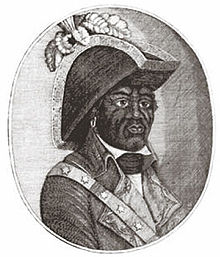
Back جورج بياسو Arabic چورچ بياسو ARZ Georges Biassou German Ζωρζ Μπιασού Greek Georges Biassou Spanish جورج بیاسو Persian Georges Biassou French Georges Biassou HT Georges Biassou NN
George Biassou | |
|---|---|
 1806 drawing of Biassou by artist Juan López Cancelada | |
| Born | January 1, 1741 Saint-Domingue, Hispaniola (now Haiti) |
| Died | July 14, 1801 (aged 60) |
| Resting place | Tolomato Cemetery |
| Other names | Jorge Biassou |
| Citizenship | Spanish |
| Years active | 1791–1795 |
| Known for | Leading the Saint-Domingue slave revolt, Spanish General |
| Honours | Guard of Honour |
George Biassou (1 January 1741 – 14 July 1801) was an early leader of the 1791 slave rising in Saint-Domingue that began the Haitian Revolution. With Jean-François and Jeannot, he was prophesied by the vodou priest Dutty Boukman to lead the revolution.
Like some other slave leaders, he fought with the Spanish royalists against the French Revolutionary authorities in colonial Haiti. Defeated by his former ally Toussaint Louverture, who had allied with the French after they promised to free the slaves, Biassou remained in service to the Spanish Crown. He withdrew from Santo Domingo in 1795 and moved with his family to Florida, which was then part of the Spanish colony of Cuba.[1]
In Florida, Biassou changed his first name to Jorge. Spanish leaders put him in charge of the black militia in Florida. He began to build alliances there when his brother-in-law married a fugitive from South Carolina. Florida had provided refuge for both planters and slaves during the American Revolution.[2]
Georges Biassou was born in 1741 on the island of Hispaniola, as a slave on a sugar plantation in the French colony of Saint-Domingue, modern day Haiti.[3] He was an early leader of the 1791 slave revolt in Saint-Domingue, in which he and his fellow leaders, Jean-François Papillon and Jeannot Bullet, killed the plantation owners to whom they were enslaved. This ultimately led to the Haitian Revolution (1791-1804). Biassou and Jean-François offered to cease the revolt, in exchange for emancipation, however France was preoccupied with multiple wars, and hence dismissed this proposal. In 1793, a war between France and Spain manifested in Hispaniola. Biassou and his fellow revolutionaries were requested to aid Spain in fighting against France in exchange for freedom, to which they agreed.[4] France abolished slavery throughout its empire in 1794, however Biassou remained loyal to Spain.[5]
In 1796, Biassou relocated to St. Augustine, Florida, where he became the general of the free black militia stationed at Fort Matanzas. He died there in 1801.[6]
- ^ Dubois, Laurent (2004). Avengers of the New World : the story of the Haitian Revolution. Harvard University Press. pp. 115–151. ISBN 9780674034365.
- ^ Berlin, Ira. Many Thousands Gone: The First Two Centuries of Slavery in North America (Cambridge, Massachusetts: Harvard University Press, 1998) pp. 306-307
- ^ Fick, Carolyn E. (1992). The Making of Haiti: The Saint Domingue Revolution from Below. The University of Tennessee Press. ISBN 0-87049-667-0.
- ^ Dubois, , Laurent (2 September 2016). Slave revolution in the Caribbean, 1789-1804 : a brief history with documents. ISBN 978-1-319-04878-5. OCLC 1048449681.
{{cite book}}: CS1 maint: multiple names: authors list (link) - ^ Landers, Jane G., 1947- (1999). Black society in Spanish Florida. University of Illinois Press. ISBN 0-252-02446-X. OCLC 906769753.
{{cite book}}: CS1 maint: multiple names: authors list (link) CS1 maint: numeric names: authors list (link) - ^ Johnson, Erika (2017). "Becoming Spanish in Florida: Georges Biassou and his "Family" in St. Augustine". Journal of Transnational American Studies. 8. doi:10.5070/T881036609.